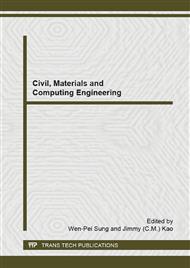p.66
p.70
p.75
p.79
p.83
p.88
p.95
p.99
p.103
Effect of Carbonization Temperature on the Elastic Modulus of Resin Carbon
Abstract:
Using the pulse excitation method, the elastic modulus of resin carbon was measured with different carbonization temperature. Micro structure of resin carbon was analyzed by XRD. Porosity, bulk density and true density of resin carbon was measured and calculated. The results show that the elastic modulus of resin carbon is 2.51GPa under 700°C carbonized, and is 2.92GPa under 1300°C carbonized. From 700°C to 1300°C, the elastic modulus of the resin carbon increases firstly and then decreases. The XRD analysis shows the crystal structure of resin carbon tends to regularization with the increase of carbonization temperature. The porosity of resin carbon is 14.% under 700°C carbonized, and is 13.38% under 1300°C carbonized. Considering XRD and porosity, the rise of elastic modulus of resin carbon from 700°C to 1000°C attributes to the incomplete pyrolysis of resin, reduction attributes to the graphitization of resin carbon from 1000°C to 1300°C.
Info:
Periodical:
Pages:
83-87
Citation:
Online since:
December 2014
Authors:
Price:
Сopyright:
© 2015 Trans Tech Publications Ltd. All Rights Reserved
Share:
Citation:


